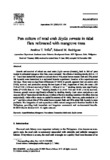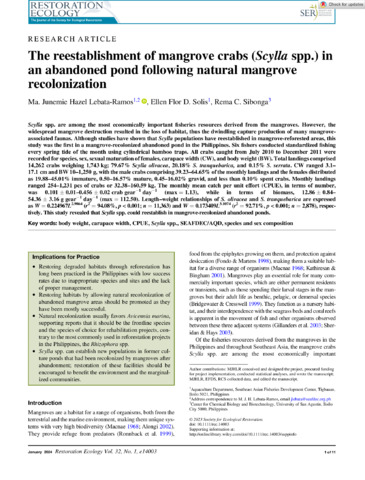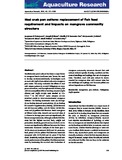Pen culture of mud crab Scylla serrata in tidal flats reforested with mangrove trees
Share
Abstract
Growth and survival of mixed sex mud crabs Scylla serrata (Forskal), held in 200 m2 pens located in reforested mangrove tidal flats, were evaluated. The effects of stocking density (0.5 or 1.5 m−2) and feed (salted fish bycatch or a mixed diet of 75% salted brown mussel flesh and 25% salted fish bycatch) were determined in a replicated factorial experiment. Duration of the experiment was 160 days. There were no significant differences (P>0.05) in growth, apparent feed conversion ratio (FCR), survival, and production among the two types of feed. Regardless of feed, the mean±SE FCR of 5.30±0.34 and survival of 56.00±1.90% at 0.5 m−2 stocking density were significantly better (P<0.05) than at 1.5 m−2 stocking density (7.6±0.63 FCR and 33.00±3.61% survival). However, growth was not significantly affected by stocking density. Cost–return analysis on a per crop per 200 m2 basis showed that the use of either of the two stocking densities with either diet was economically viable with a return on capital investment of 49–68%. However, crabs stocked at 1.5 m−2 and fed a mixed diet of 75% salted brown mussel flesh and 25% salted fish bycatch is more profitable. The integration of crab aquaculture within natural mangroves is therefore feasible in the Philippines, providing both immediate and long-term commercial and environmental benefits.
Suggested Citation
Triño, A. T., & Rodriguez, E. M. (2002). Pen culture of mud crab Scylla serrata in tidal flats reforested with mangrove trees. Aquaculture , 211(1-4), 125-134. https://doi.org/10.1016/S0044-8486(01)00890-0
Subject
Taxonomic term
Collections
- AQD Journal Articles [1249]
Related items
Showing items related by title, author, creator and subject.
-
Mud crab pond and pen culture
Rodriguez, Eduard M. (University of the Philippines Aquaculture Society, Inc, 2001) -
The reestablishment of mangrove crabs (Scylla spp.) in an abandoned pond following natural mangrove recolonization
Lebata-Ramos, Ma. Junemie Hazel; Solis, Ellen Flor D.; Sibonga, Rema (Wiley, 2024-01)Scylla spp. are among the most economically important fisheries resources derived from the mangroves. However, the widespread mangrove destruction resulted in the loss of habitat, thus the dwindling capture production ... -
Mud crab pen culture: replacement of fish feed requirement and impacts on mangrove community structure
Primavera, Jurgenne; Binas, Joseph B.; Samonte-Tan, Giselle P. B.; Lebata, Ma. Junemie J.; Alava, Veronica R.; Walton, Mark; LeVay, Lewis (Blackwell Publishing, 2010)Brackishwater pond culture has been a major factor in mangrove loss in Southeast Asia, hence, the need to develop environment-friendly technologies such as mud crab Scylla (Portunidae) culture in mangrove pens exists. This ...




